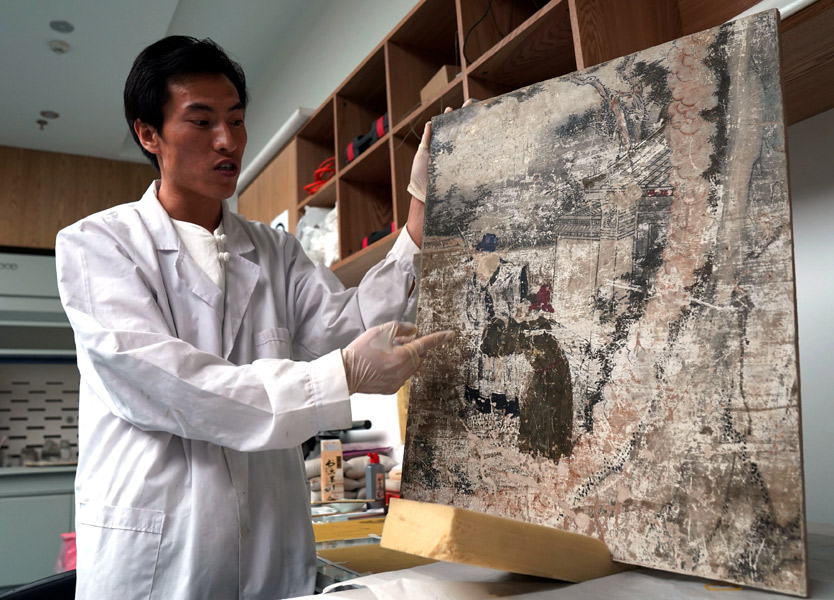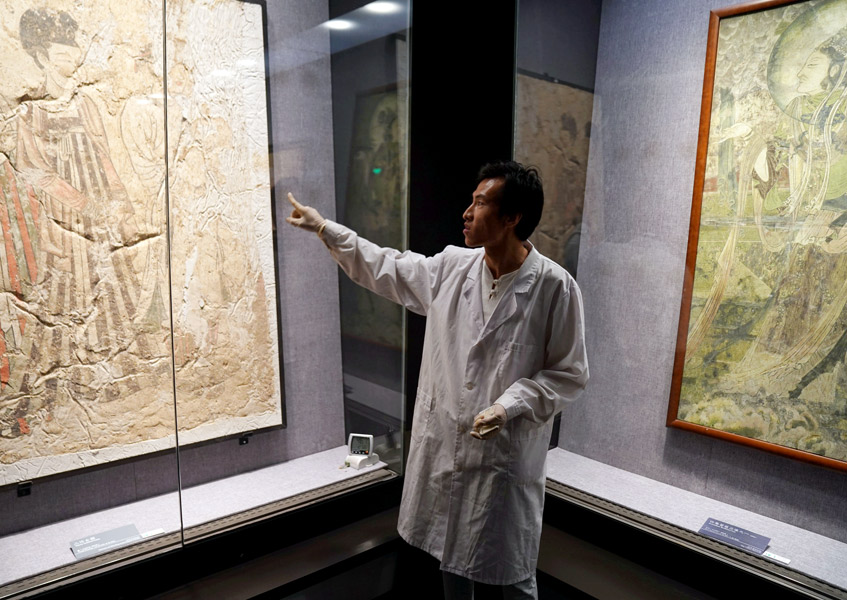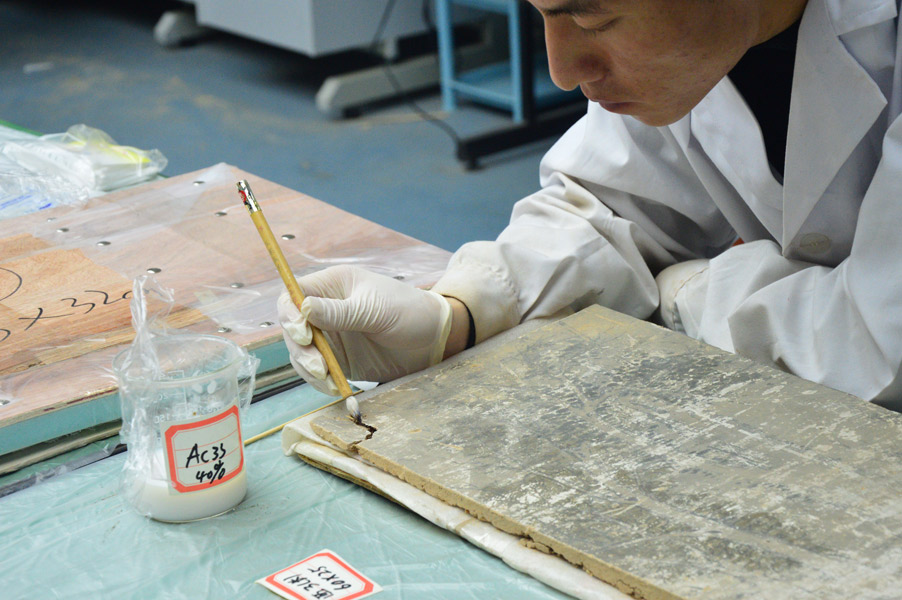
Li Sen has worked for the Mural Conservation and Restoration Center at the Xi'an Qujiang Museum of Fine Arts for five years. [PHOTO BY HUO YAN/CHINA DAILY]
Li Sen goes about his work with all the care of a surgeon, and the reward is seeing ailing pieces of history come back to life
In the basement of a five-star hotel in Xi'an, Shaanxi province, the battle to restore a mural painting from the Qing Dynasty (1644-1911) is in full swing.
Li Sen, wearing a white coat and gloves, is busy safeguarding this cultural heritage, which was saved from an abandoned temple of a small village in Fengxiang county in the west of Shaanxi province in 2014.
The painting, which depicts pilgrims worshipping the god and goddess of the temple, is about 12 square meters. It has been divided into more than 20 pieces, and the restoration is due to be completed next year.
"These murals are irreplaceable," Li says.
"Whenever I touch them I have to take extraordinary care."
Explaining his work, Li says: "One of the most used tools (in restoration) is the surgical blade, and when you're restoring murals it's like a doctor doing surgery. So there is a great deal of fulfillment and exhilaration in saving a mural."
Li, 30, has worked for the Mural Conservation and Restoration Center at the Xi'an Qujiang Museum of Fine Arts for five years. In conjunction with the Shaanxi Provincial Institute of Archaeology, the center conserves, does research on and restores and exhibits ancient murals. The center has also restored 16 murals from the Ordos Bronzeware Museum in the Inner Mongolia autonomous region, a project Li had a role in.
The center was set up by Zhou Tianyou, 74, director of the Xi'an Qujiang Museum of Fine Arts.

Li Sen, wearing a white coat and gloves, safeguards murals saved from the abandoned temple of a small village in Fengxiang county in the west of Shaanxi province in 2014. [PHOTO BY HUO YAN/CHINA DAILY]
The museum, which opened in 2012 and is housed in the Westin Xi'an Hotel, is one of the first private museums in China to combine its operations with an international five-star hotel.
Zhou was director of the Shaanxi History Museum from 1995 to 2004. Li works eight hours a day, five days a week, for the five-year-long restoration, which involves cleaning the painting, joining the pieces with materials made of timber, and repairing degraded color. He stops every hour or so to rest his eyes and hands.
"When the mural painting was discovered in the temple it was in very bad shape," Li says. "The local villagers had no idea that it was special and deserved protection. Natural elements such as rain and wind had eroded it. It took a long time to remove the mud slowly, until the face of the characters on the painting revealed themselves."
Li, who was born into a farmer family in Yulin, Shaanxi province, joined the center five years after graduating from Shaanxi Conservation College. He started with imitating the murals, cutting the paintings from the walls and then repairing them.
He likes reading history books and traveling nationwide visiting sites with mural paintings, such as the Mogao Grottoes in Dunhuang, Gansu province, he says.

Li Sen, wearing a white coat and gloves, safeguards murals saved from the abandoned temple of a small village in Fengxiang county in the west of Shaanxi province in 2014. [PHOTO BY HUO YAN/CHINA DAILY]
He joined the Xi'an Qujiang Museum of Fine Arts because of Zhou's reputation, he says. The museum director has curated a permanent exhibition for Xi'an Qujiang Museum of Fine Arts, titled Origin and History of Ancient Chinese Murals, set in a 1,000-square-meter hall, features 88 panels (67 of them original) from the Neolithic period to the Qing Dynasty. Li says he admired Zhou's passion for recounting Chinese history using murals.
Li, the youngest child in his family, has loved traditional Chinese painting since childhood, he says. He used to spend his pocket money on painting books and lianhuanhua, a Chinese palm-size black-and-white book of sequential drawings found in China in the early 20th century.
"I am very shy and quiet. The job suits me. When I look at the resurrected murals it feels as though all the characters have come alive, just like in the lianhuanhua I read as a child."
Li says his parents were not very supportive about his job decision.
"They didn't know the job until they came to the studio and watched the mural painting exhibition at the museum. Murals transcend art. They tell of history and culture from thousands of years ago. My parents are now proud and happy for me because this job not only provides me with a living but has fulfilled a dream."

Li Sen, wearing a white coat and gloves, safeguards murals saved from the abandoned temple of a small village in Fengxiang county in the west of Shaanxi province in 2014. [PHOTO BY HUO YAN/CHINA DAILY]


